Konrad Rieck
Adversarial Observations in Weather Forecasting
Apr 22, 2025Abstract:AI-based systems, such as Google's GenCast, have recently redefined the state of the art in weather forecasting, offering more accurate and timely predictions of both everyday weather and extreme events. While these systems are on the verge of replacing traditional meteorological methods, they also introduce new vulnerabilities into the forecasting process. In this paper, we investigate this threat and present a novel attack on autoregressive diffusion models, such as those used in GenCast, capable of manipulating weather forecasts and fabricating extreme events, including hurricanes, heat waves, and intense rainfall. The attack introduces subtle perturbations into weather observations that are statistically indistinguishable from natural noise and change less than 0.1% of the measurements - comparable to tampering with data from a single meteorological satellite. As modern forecasting integrates data from nearly a hundred satellites and many other sources operated by different countries, our findings highlight a critical security risk with the potential to cause large-scale disruptions and undermine public trust in weather prediction.
On the Role of Pre-trained Embeddings in Binary Code Analysis
Feb 12, 2025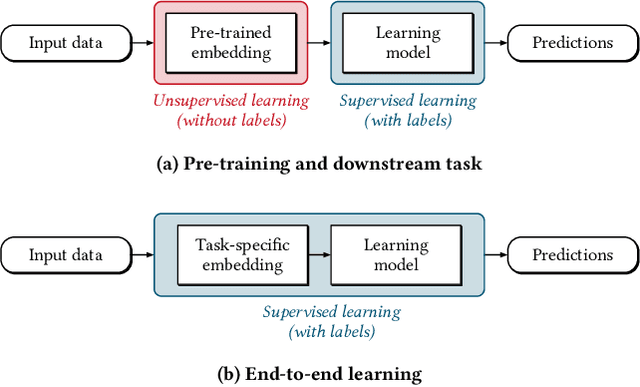


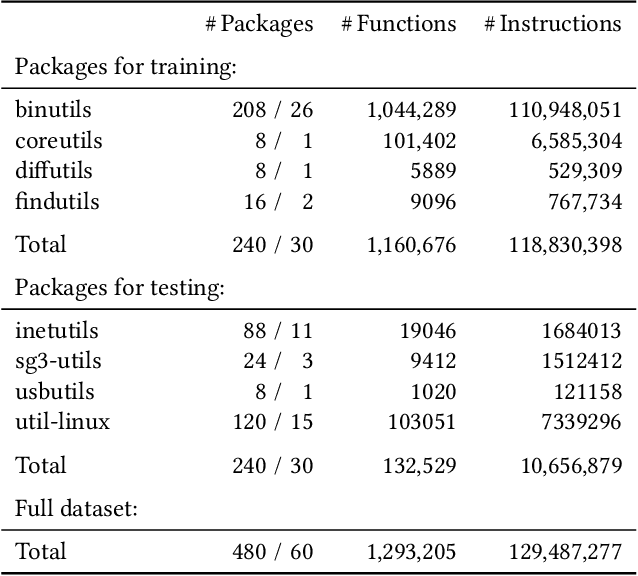
Abstract:Deep learning has enabled remarkable progress in binary code analysis. In particular, pre-trained embeddings of assembly code have become a gold standard for solving analysis tasks, such as measuring code similarity or recognizing functions. These embeddings are capable of learning a vector representation from unlabeled code. In contrast to natural language processing, however, label information is not scarce for many tasks in binary code analysis. For example, labeled training data for function boundaries, optimization levels, and argument types can be easily derived from debug information provided by a compiler. Consequently, the main motivation of embeddings does not transfer directly to binary code analysis. In this paper, we explore the role of pre-trained embeddings from a critical perspective. To this end, we systematically evaluate recent embeddings for assembly code on five downstream tasks using a corpus of 1.2 million functions from the Debian distribution. We observe that several embeddings perform similarly when sufficient labeled data is available, and that differences reported in prior work are hardly noticeable. Surprisingly, we find that end-to-end learning without pre-training performs best on average, which calls into question the need for specialized embeddings. By varying the amount of labeled data, we eventually derive guidelines for when embeddings offer advantages and when end-to-end learning is preferable for binary code analysis.
Manipulating Feature Visualizations with Gradient Slingshots
Jan 11, 2024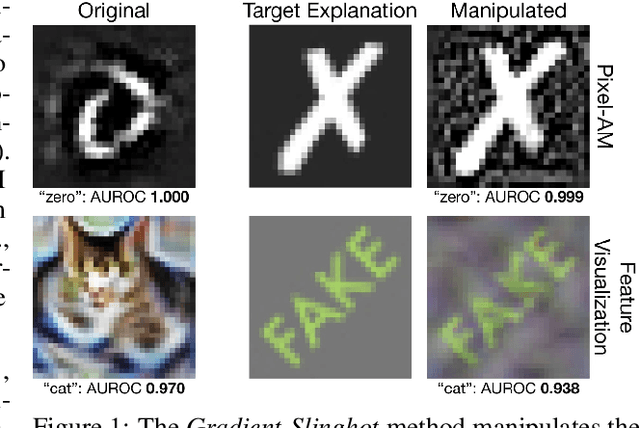
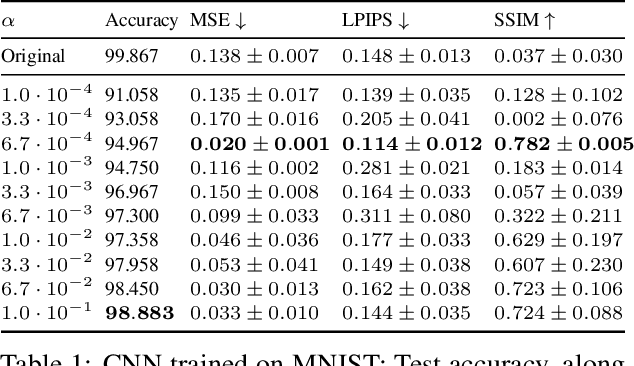

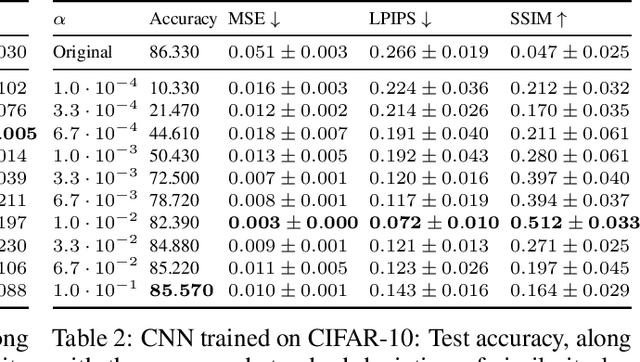
Abstract:Deep Neural Networks (DNNs) are capable of learning complex and versatile representations, however, the semantic nature of the learned concepts remains unknown. A common method used to explain the concepts learned by DNNs is Activation Maximization (AM), which generates a synthetic input signal that maximally activates a particular neuron in the network. In this paper, we investigate the vulnerability of this approach to adversarial model manipulations and introduce a novel method for manipulating feature visualization without altering the model architecture or significantly impacting the model's decision-making process. We evaluate the effectiveness of our method on several neural network models and demonstrate its capabilities to hide the functionality of specific neurons by masking the original explanations of neurons with chosen target explanations during model auditing. As a remedy, we propose a protective measure against such manipulations and provide quantitative evidence which substantiates our findings.
On the Detection of Image-Scaling Attacks in Machine Learning
Oct 23, 2023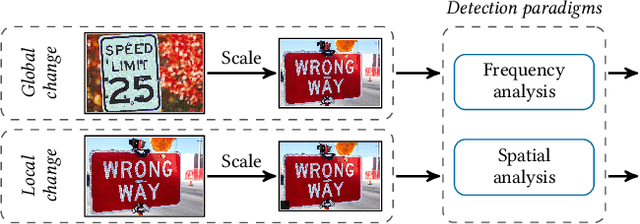



Abstract:Image scaling is an integral part of machine learning and computer vision systems. Unfortunately, this preprocessing step is vulnerable to so-called image-scaling attacks where an attacker makes unnoticeable changes to an image so that it becomes a new image after scaling. This opens up new ways for attackers to control the prediction or to improve poisoning and backdoor attacks. While effective techniques exist to prevent scaling attacks, their detection has not been rigorously studied yet. Consequently, it is currently not possible to reliably spot these attacks in practice. This paper presents the first in-depth systematization and analysis of detection methods for image-scaling attacks. We identify two general detection paradigms and derive novel methods from them that are simple in design yet significantly outperform previous work. We demonstrate the efficacy of these methods in a comprehensive evaluation with all major learning platforms and scaling algorithms. First, we show that image-scaling attacks modifying the entire scaled image can be reliably detected even under an adaptive adversary. Second, we find that our methods provide strong detection performance even if only minor parts of the image are manipulated. As a result, we can introduce a novel protection layer against image-scaling attacks.
Learning Type Inference for Enhanced Dataflow Analysis
Oct 04, 2023Abstract:Statically analyzing dynamically-typed code is a challenging endeavor, as even seemingly trivial tasks such as determining the targets of procedure calls are non-trivial without knowing the types of objects at compile time. Addressing this challenge, gradual typing is increasingly added to dynamically-typed languages, a prominent example being TypeScript that introduces static typing to JavaScript. Gradual typing improves the developer's ability to verify program behavior, contributing to robust, secure and debuggable programs. In practice, however, users only sparsely annotate types directly. At the same time, conventional type inference faces performance-related challenges as program size grows. Statistical techniques based on machine learning offer faster inference, but although recent approaches demonstrate overall improved accuracy, they still perform significantly worse on user-defined types than on the most common built-in types. Limiting their real-world usefulness even more, they rarely integrate with user-facing applications. We propose CodeTIDAL5, a Transformer-based model trained to reliably predict type annotations. For effective result retrieval and re-integration, we extract usage slices from a program's code property graph. Comparing our approach against recent neural type inference systems, our model outperforms the current state-of-the-art by 7.85% on the ManyTypes4TypeScript benchmark, achieving 71.27% accuracy overall. Furthermore, we present JoernTI, an integration of our approach into Joern, an open source static analysis tool, and demonstrate that the analysis benefits from the additional type information. As our model allows for fast inference times even on commodity CPUs, making our system available through Joern leads to high accessibility and facilitates security research.
* - fixed last author's name - fixed header
Evil from Within: Machine Learning Backdoors through Hardware Trojans
Apr 18, 2023



Abstract:Backdoors pose a serious threat to machine learning, as they can compromise the integrity of security-critical systems, such as self-driving cars. While different defenses have been proposed to address this threat, they all rely on the assumption that the hardware on which the learning models are executed during inference is trusted. In this paper, we challenge this assumption and introduce a backdoor attack that completely resides within a common hardware accelerator for machine learning. Outside of the accelerator, neither the learning model nor the software is manipulated, so that current defenses fail. To make this attack practical, we overcome two challenges: First, as memory on a hardware accelerator is severely limited, we introduce the concept of a minimal backdoor that deviates as little as possible from the original model and is activated by replacing a few model parameters only. Second, we develop a configurable hardware trojan that can be provisioned with the backdoor and performs a replacement only when the specific target model is processed. We demonstrate the practical feasibility of our attack by implanting our hardware trojan into the Xilinx Vitis AI DPU, a commercial machine-learning accelerator. We configure the trojan with a minimal backdoor for a traffic-sign recognition system. The backdoor replaces only 30 (0.069%) model parameters, yet it reliably manipulates the recognition once the input contains a backdoor trigger. Our attack expands the hardware circuit of the accelerator by 0.24% and induces no run-time overhead, rendering a detection hardly possible. Given the complex and highly distributed manufacturing process of current hardware, our work points to a new threat in machine learning that is inaccessible to current security mechanisms and calls for hardware to be manufactured only in fully trusted environments.
No more Reviewer #2: Subverting Automatic Paper-Reviewer Assignment using Adversarial Learning
Mar 25, 2023



Abstract:The number of papers submitted to academic conferences is steadily rising in many scientific disciplines. To handle this growth, systems for automatic paper-reviewer assignments are increasingly used during the reviewing process. These systems use statistical topic models to characterize the content of submissions and automate the assignment to reviewers. In this paper, we show that this automation can be manipulated using adversarial learning. We propose an attack that adapts a given paper so that it misleads the assignment and selects its own reviewers. Our attack is based on a novel optimization strategy that alternates between the feature space and problem space to realize unobtrusive changes to the paper. To evaluate the feasibility of our attack, we simulate the paper-reviewer assignment of an actual security conference (IEEE S&P) with 165 reviewers on the program committee. Our results show that we can successfully select and remove reviewers without access to the assignment system. Moreover, we demonstrate that the manipulated papers remain plausible and are often indistinguishable from benign submissions.
I still know it's you! On Challenges in Anonymizing Source Code
Aug 26, 2022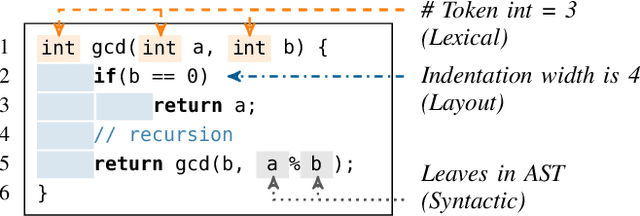
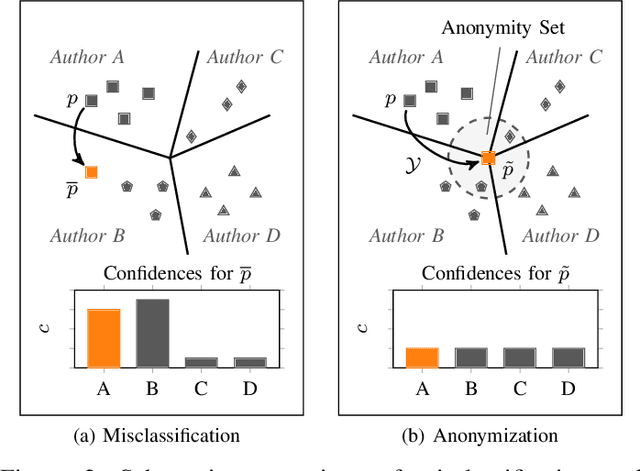

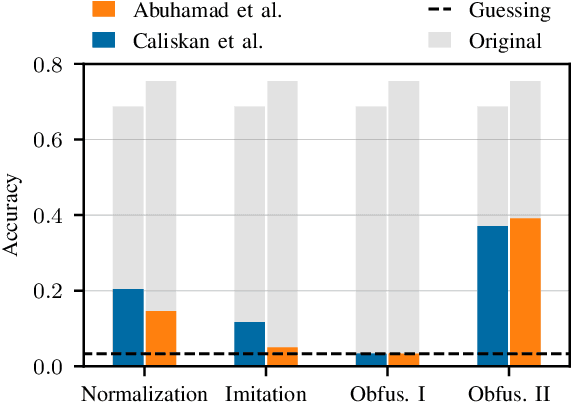
Abstract:The source code of a program not only defines its semantics but also contains subtle clues that can identify its author. Several studies have shown that these clues can be automatically extracted using machine learning and allow for determining a program's author among hundreds of programmers. This attribution poses a significant threat to developers of anti-censorship and privacy-enhancing technologies, as they become identifiable and may be prosecuted. An ideal protection from this threat would be the anonymization of source code. However, neither theoretical nor practical principles of such an anonymization have been explored so far. In this paper, we tackle this problem and develop a framework for reasoning about code anonymization. We prove that the task of generating a $k$-anonymous program -- a program that cannot be attributed to one of $k$ authors -- is not computable and thus a dead end for research. As a remedy, we introduce a relaxed concept called $k$-uncertainty, which enables us to measure the protection of developers. Based on this concept, we empirically study candidate techniques for anonymization, such as code normalization, coding style imitation, and code obfuscation. We find that none of the techniques provides sufficient protection when the attacker is aware of the anonymization. While we introduce an approach for removing remaining clues from the code, the main result of our work is negative: Anonymization of source code is a hard and open problem.
Misleading Deep-Fake Detection with GAN Fingerprints
May 25, 2022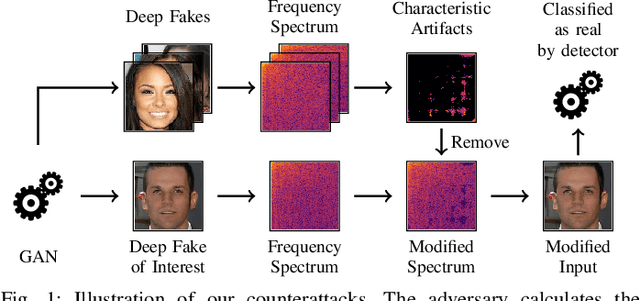


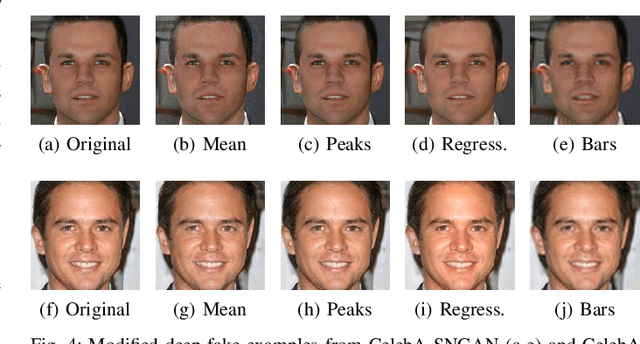
Abstract:Generative adversarial networks (GANs) have made remarkable progress in synthesizing realistic-looking images that effectively outsmart even humans. Although several detection methods can recognize these deep fakes by checking for image artifacts from the generation process, multiple counterattacks have demonstrated their limitations. These attacks, however, still require certain conditions to hold, such as interacting with the detection method or adjusting the GAN directly. In this paper, we introduce a novel class of simple counterattacks that overcomes these limitations. In particular, we show that an adversary can remove indicative artifacts, the GAN fingerprint, directly from the frequency spectrum of a generated image. We explore different realizations of this removal, ranging from filtering high frequencies to more nuanced frequency-peak cleansing. We evaluate the performance of our attack with different detection methods, GAN architectures, and datasets. Our results show that an adversary can often remove GAN fingerprints and thus evade the detection of generated images.
Machine Unlearning of Features and Labels
Aug 26, 2021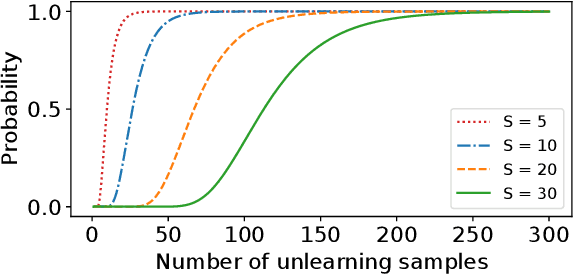

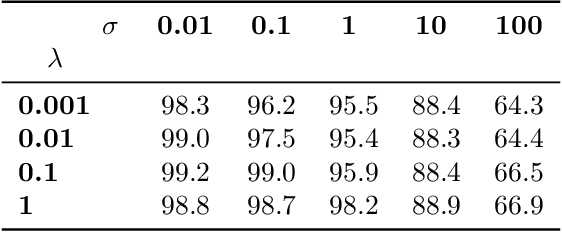
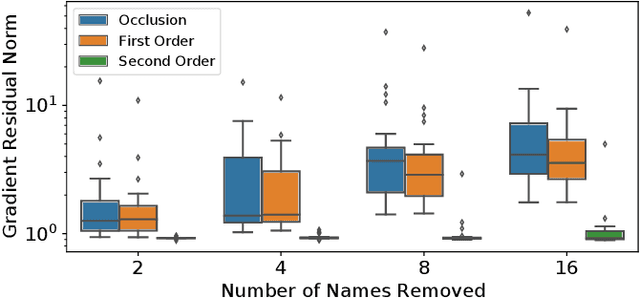
Abstract:Removing information from a machine learning model is a non-trivial task that requires to partially revert the training process. This task is unavoidable when sensitive data, such as credit card numbers or passwords, accidentally enter the model and need to be removed afterwards. Recently, different concepts for machine unlearning have been proposed to address this problem. While these approaches are effective in removing individual data points, they do not scale to scenarios where larger groups of features and labels need to be reverted. In this paper, we propose a method for unlearning features and labels. Our approach builds on the concept of influence functions and realizes unlearning through closed-form updates of model parameters. It enables to adapt the influence of training data on a learning model retrospectively, thereby correcting data leaks and privacy issues. For learning models with strongly convex loss functions, our method provides certified unlearning with theoretical guarantees. For models with non-convex losses, we empirically show that unlearning features and labels is effective and significantly faster than other strategies.
 Add to Chrome
Add to Chrome Add to Firefox
Add to Firefox Add to Edge
Add to Edge